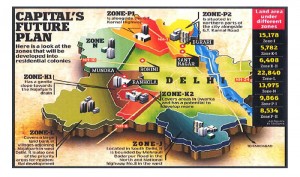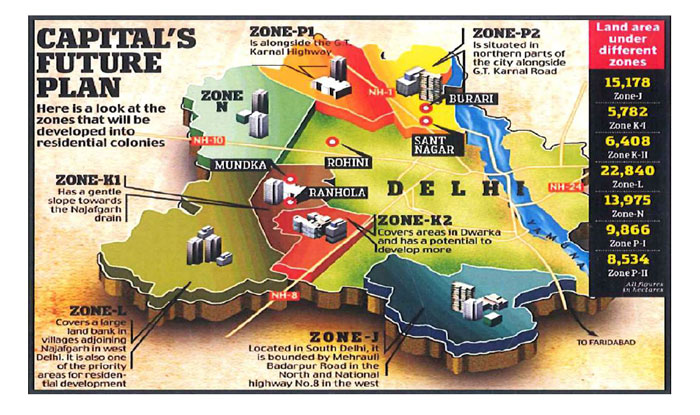Track2Realty Exclusive
 Why do you buy a house in Noida, Noida Extension, Ghaziabad, Faridabad or even non-descript & hard-to-commute locations of NCR when you work in Delhi? If affordability is not the issue, won’t you prefer to live in the capital Delhi and not the satellite cities of NCR?
Why do you buy a house in Noida, Noida Extension, Ghaziabad, Faridabad or even non-descript & hard-to-commute locations of NCR when you work in Delhi? If affordability is not the issue, won’t you prefer to live in the capital Delhi and not the satellite cities of NCR?
The answer to this and many other compromised housing solution of most of the residents of Delhi-NCR lies in the land pooling policy of the Delhi Development Authority (DDA). The land pooling policy, which had been notified earlier in September 2013, has finally been approved by the city’s Lieutenant Governor (LG) recently. This policy will enable urban development in a speedy way where the role of the DDA will be that of a facilitator.
The land pooling policy will facilitate private developers to directly acquire land from farmers/landowners willing to participate in the land pooling scheme, where they will get back about 40–60 per cent of the developed land. DDA, in turn, is to develop the necessary support infrastructure and mass/EWS housing projects on the land, while developers are to receive a large portion of the same for further real estate development. With this policy there will be creation of additional 14 lakh residential units under the PPP model.
DDA in its meeting held on 7th of November this year has approved the regulations for operationalisation of this land pooling policy wherein public private partnership in land assembly and its development has been envisaged. DDA has acquired and developed 75,610 hectares of land till date. As per the Master Plan of Delhi-2021, Delhi still has 27,629 hectares (approx 70,000 acres of land.
The Master Plan of Delhi 2021 envisages development of about 24,000 hectares of land for accommodating additional 48 lakh population in the national capital by the year 2021. The total area of Delhi is 1483 sq mt, out of which built up area is 47.31 per cent, urban extension 14.83 per cent, natural features such as river, water bodies, ridge, forest and sanctuary 13.16 per cent and green belt is 24.25 per cent. Approx 220 sq km at 250 PPH (Person Per Hectare – city level density) would come under urban extension 2021 and average space would be 40 sq m for 230 lakh population in 2021.
Under the Master Plan – 2021, never in the history of urbanisation has any state released the entire land mass for 100 per cent urbanisation. Under the proposed plan, Delhi is unlocking 27,500 hectares of zoned land for residential development (Master Plan and Zonal Plan already notified) and there will be no agriculture land in Delhi by 2021; neither there will be any air polluting industry. Further, land will be available at cheaper cost within the NCR region and the last peripheral village of Delhi has been notified as the Green, which allows development of farm houses.
The likely localities to be applicable for such real estate and infrastructure development will be peripheral colonies and villages such as Mehrauli, Chhatarpur, Khanpur, Narela, and Najafgarh, among others. This policy is expected to prove to be positive for the National Capital Region in the long-term, since land prices in the suburban markets of Gurgaon and Noida would eventually rationalize with fresh housing supply coming into the Delhi market.
Calling it a game changer move, Anshuman Magazine, CMD of CBRE South Asia maintains that the Master Plan Delhi 2021 (MPD 2021) is arguably the largest real estate opportunity in terms of state assurance and demographic demand for urban growth and development in India; and the recently sanctioned land pooling policy is perhaps the first of many such state initiatives.
“Land pooling schemes, such as this, are expected to help solve issues related to the availability of land for necessary real estate development and infrastructure formation for our ever-increasing urban population—especially for the creation of urban green spaces, open public spaces and mass housing for EWS and low-income groups,” says Magazine.
Rahul Gaur, CMD of Brys Group maintains that this policy assures fundamental changes in the way of acquisition and development of land in Delhi. He points out the DDA earlier used to acquire land from landowners, provide the infrastructure, and then auction it to developers. The price at these auctions ranged from 10-30 times the acquisition price. While the DDA made a killing, the landowners did not share the benefits. This led to criticism that the DDA was profiteering at their expense.
“Land pooling is aimed at countering the criticism of DDA profiteering out of an urban need. Now, the DDA, landowners, and developers will join hands. The landowners in an area will transfer their legal rights to a designated land pooling agency. In return, they will receive certificates that will entitle them to developed land in the future, its amount depending on a specified formula. The DDA will provide the infrastructure, and private developers will develop the projects. Once the development work is done, the land that the owners receive will command a higher price than their original holdings,” says Gaur.
Nikhil Hawelia, Managing Director of Hawelia Group finds the game changer move of DDA in sync with the emerging market realities. According to him, the first Master Plan of Delhi was formulated in the year 1961. The policy then of DDA was to acquire large chunks of land directly from the land owners at a price determined by the DDA. DDA would then undertake the master planning and then sell/develop the land, piece by piece.
“From the 1980’s, as the government body failed to keep pace with the urbanisation and housing needs the private developers, through their incremental ability, rightfully started seeking a larger role. In the past couple decades, the demand surge from the consumers actually made the supply from the government agencies inadequate. And hence, the majority of supply was created by the private real estate players. Today, land pooling is also finding favour because land acquisition has become very difficult. Currently, a private entity acquiring land must obtain the consent of 80 per cent of the land-owning families in the area (70 per cent in the case of public-private partnership projects). Obtaining consensus is also difficult,” says Hawelia.
In a nutshell, land pooling will increase the supply of land, resulting in price moderation. Besides Delhi, there could be a ripple effect in the suburbs. With fresh supply coming into the Delhi market, land prices in suburbs like Gurgaon and Noida will also moderate eventually. As a result, the cost of built-up real estate in general and housing in particular will come down since land is the biggest cost component. However, analysts have a word of caution and they suggest prospective home buyers should temper their expectations. The prices will correct sharply only if supply increases drastically. If new supply enters the market slowly, as is likely, the prices may not fall much.






1 Comment
There is still no clear policy on this. DDA comes out with ads in the newspaper every now and then which says that they have yet not cleared this policy.